Pilot Protection Based on Amplitude of Directional Travelling Wave for Voltage Source Converter-High Voltage Direct Current (VSC-HVDC) Transmission Lines
Abstract
:1. Introduction
2. Protection Prepare
2.1. Wavelet Analysis Theory
2.2. Phase-Mode Transform Method for Bipolar Cable
3. TW Characteristic Analysis
3.1. Basic Theory Analysis for Two-Terminal DC Grid
3.2. Basic Theory Analysis for Four-Terminal DC Grid
- (a)
- If the amplitudes of FTWC and BTWC detected by Dij and Dji, respectively, are both approximate to each other, an internal fault in line i, j can be distinguished;
- (b)
- If the amplitude of FTWC is much larger than BTWC for Dij or Dji, an external fault in line i, j can be judged.
4 Protection Criterion
4.1. Fault-Line Determination Criterion
4.2. Fault-Pole Selection Criterion
5. Simulation and Analysis
5.1. Simulation Model
5.2. Typical Fault Simulation
5.2.1. Positive Pole to Ground (PG) Fault
5.2.2. Negative Pole to Ground (NG) Fault
5.2.3. Bipolar Short-Circuit Fault
5.2.4. External Fault
5.3. Simulation for Influencing Factors
5.3.1. Different Fault Resistances
5.3.2. Influence of Noise Disturbance
6. Conclusions
Author Contributions
Acknowledgments
Conflicts of Interest
References
- Flourentzou, N.; Agelidis, V.G.; Demetriades, G.D. VSC-Based HVDC power transmission systems: An overview. IEEE Trans. Power Electron. 2009, 24, 592–602. [Google Scholar] [CrossRef]
- Peralta, J.; Saad, H.; Dennetiere, S.; Mahseredjian, J.; Nguefeu, S. Detailed and averaged models for a 401-level MMC–HVDC system. IEEE Trans. Power Deliv. 2012, 27, 1501–1508. [Google Scholar] [CrossRef]
- Yang, Y.; Mao, C.; Wang, D.; Tian, J.; Yang, M. Modeling and analysis of the common mode voltage in a Cascaded H-Bridge Electronic Power Transformer. Energies 2017, 10, 1357. [Google Scholar] [CrossRef]
- Li, X.; Song, Q.; Liu, W.; Rao, H.; Xu, S.; Li, L. Protection of nonpermanent faults on DC overhead lines in MMC-Based HVDC systems. IEEE Trans. Power Deliv. 2012, 28, 483–490. [Google Scholar] [CrossRef]
- Tang, L.X.; Ooi, B.T. Locating and iolating DC faults in multi-terminal DC systems. IEEE Trans. Power Deliv. 2007, 22, 1877–1884. [Google Scholar] [CrossRef]
- De Kerf, K.; Srivastava, K.; Reza, M.; Bekaert, D.; Cole, S.; Van Hertem, D.; Belmans, R. Wavelet-based protection strategy for DC faults in multi-terminal VSC HVDC systems. IET Gener. Transm. Distrib. 2011, 5, 496–503. [Google Scholar] [CrossRef]
- Naidoo, D.; Ijumba, N.M. HVDC line protection for the proposed future HVDC systems. In Proceedings of the International Conference on Power System Technology, Singapore, 21–24 November 2004; Volume 2, pp. 1327–1332. [Google Scholar]
- Liu, X.; Osman, A.H.; Malik, O.P. Hybrid traveling wave/boundary protection for monopolar HVDC line. IEEE Trans. Power Deliv. 2009, 24, 569–578. [Google Scholar] [CrossRef]
- Song, G.; Cai, X.; Gao, S.; Suonan, J.; Li, G. Novel current differential protection principle of VSC-HVDC considering frequency-dependent characteristic of cable line. Proc. CSEE 2011, 31, 105–111. (In Chinese) [Google Scholar]
- Ha, H.X.; Yu, Y.; Yi, R.P.; Bo, Z.Q.; Chen, B. Novel scheme of travelling wave based differential protection for bipolar HVDC transmission lines. In Proceedings of the 2010 International Conference on Power System Technology, Hangzhou, China, 24–28 October 2010. [Google Scholar]
- Wang, L.; Chen, Q.; Xi, C. Study on the travelling wave differential protection and the improvement scheme for VSC-HVDC transmission lines. In Proceedings of the 2016 IEEE PES Asia-Pacific Power and Energy Engineering Conference (APPEEC), Xi’an, China, 25–28 October 2016. [Google Scholar]
- Zhao, P.; Chen, Q.; Sun, K. A novel protection method for VSC-MTDC cable based on the transient DC current using the S transform. Int. J. Electr. Power Energy Syst. 2018, 97, 299–308. [Google Scholar] [CrossRef]
- Jin, X.; Song, G.; Ma, Z. A novel pilot protection for VSC-HVDC transmission lines based on parameter identification. In Proceedings of the 12th IET International Conference on Developments in Power System Protection (DPSP 2014), Copenhagen, Denmark, 31 March–3 April 2014. [Google Scholar]
- Zheng, X.; Tai, N.; Wu, Z.; Thorp, J. Harmonic current protection scheme for voltage source converter-based high-voltage direct current transmission system. IET Gener. Transm. Distrib. 2014, 8, 1509–1515. [Google Scholar] [CrossRef]
- Song, G.; Cai, X.; Gao, S.; Suonan, J.; Li, G. Natural frequency based protection and fault location for VSC-HVDC transmission lines. In Proceedings of the 2011 International Conference on Advanced Power System Automation and Protection, Beijing, China, 16–20 October 2011. [Google Scholar]
- Zou, G.; Feng, Q.; Huang, Q.; Sun, C.; Gao, H. A fast protection scheme for VSC based multi-terminal DC grid. Electr. Power Energy Syst. 2018, 98, 307–314. [Google Scholar] [CrossRef]
- Zhang, S.; Zou, G.; Huang, Q.; Gao, H. A Traveling-Wave-Based Fault Location Scheme for MMC-Based Multi-Terminal DC Grids. Energies 2018, 11, 401. [Google Scholar] [CrossRef]
- Chang, B.; Cwikowski, O.; Barnes, M.; Shuttleworth, R.; Beddard, A.; Coventry, P. Review of different fault detection methods and their impact on pre-emptive VSC-HVDC dc protection performance. High Volt. 2018, 2, 211–219. [Google Scholar] [CrossRef]
- Xing, L.H.; Chen, Q.; Xue, B.L. A Fault Location Method for HVDC Transmission Lines. Appl. Mech. Mater. 2014, 556–562, 2723–2727. [Google Scholar] [CrossRef]
- Habib, S.; Kordi, B. Calculation of Multiconductor Underground Cables High-Frequency Per-Unit-Length Parameters Using Electromagnetic Modal Analysis. IEEE Trans. Power Deliv. 2013, 28, 276–284. [Google Scholar] [CrossRef]
- Li, B.; Zhang, Y. Calculation Method of Equivalent Core Impedance and Admittance Parameters of 3-Phase Single-Core Power Cable. J. Tianjin Univ. Sci. Technol. 2016, 49, 1144–1150. [Google Scholar]
- Zhao, P.; Chen, Q.; Sun, K.; Xu, C. A Current Frequency Component-Based Fault-Location Method for Voltage-Source Converter-Based High-Voltage Direct Current (VSC-HVDC) Cables Using the S Transform. Energies 2017, 10, 1115. [Google Scholar] [CrossRef]
- Song, G.; Cai, X.; Gao, S. Directional element for VSCHVDC transmission lines based on model identification. Power Syst. Prot. Control 2012, 40, 78–83. [Google Scholar]
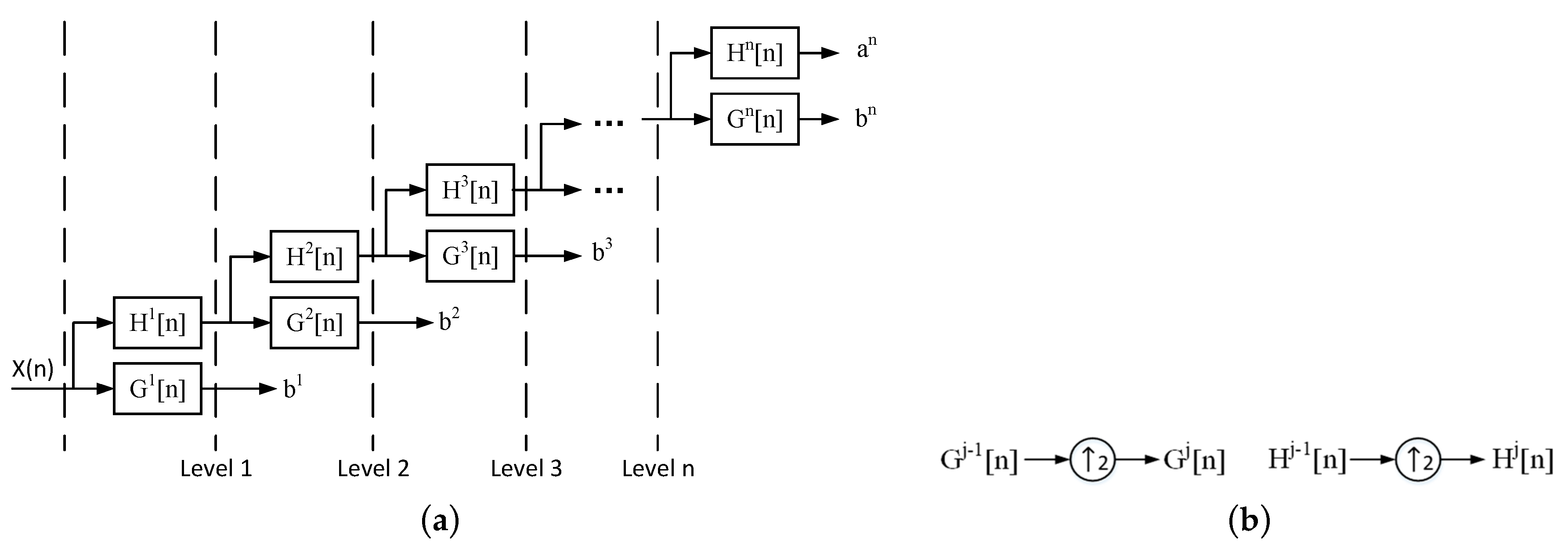
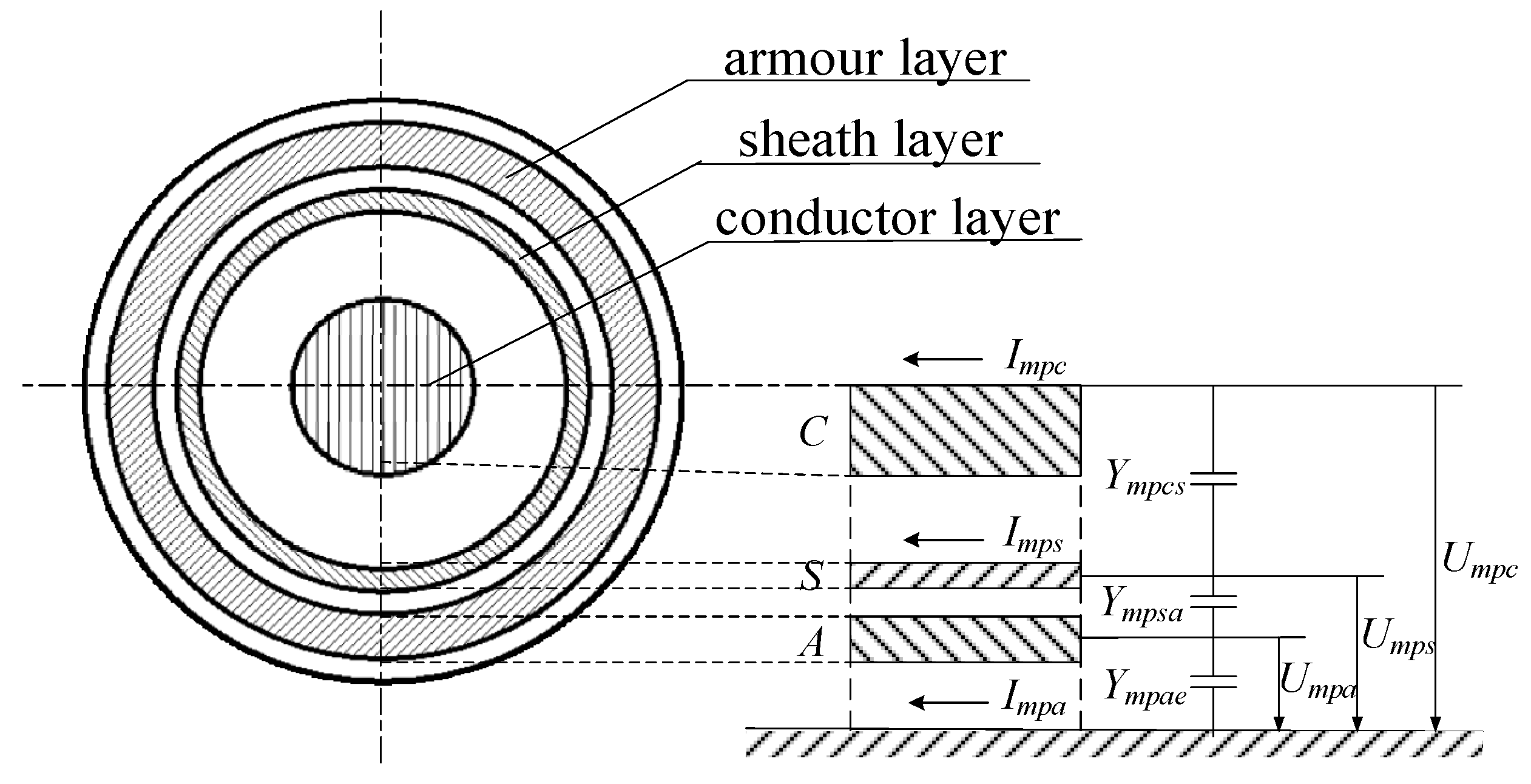



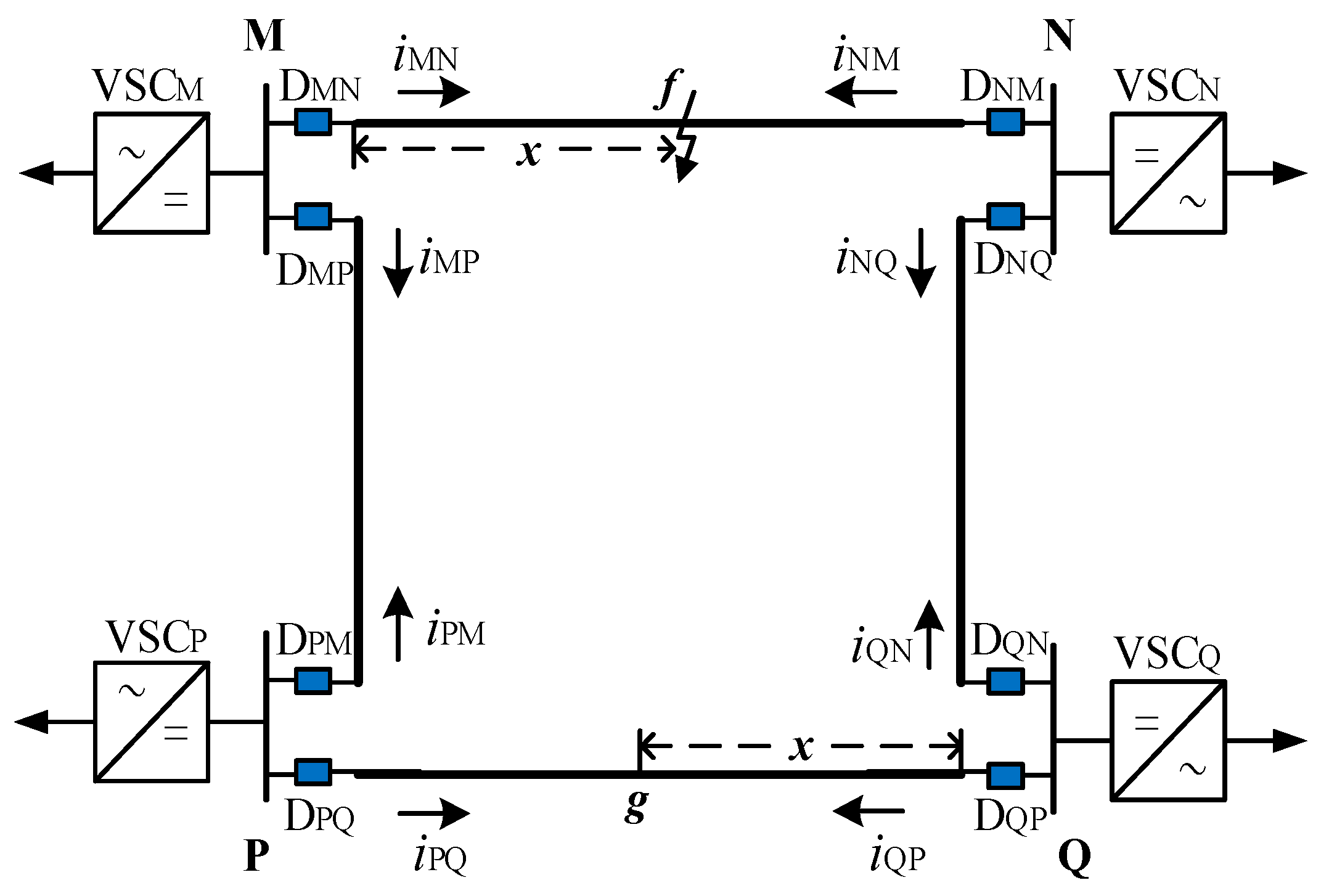
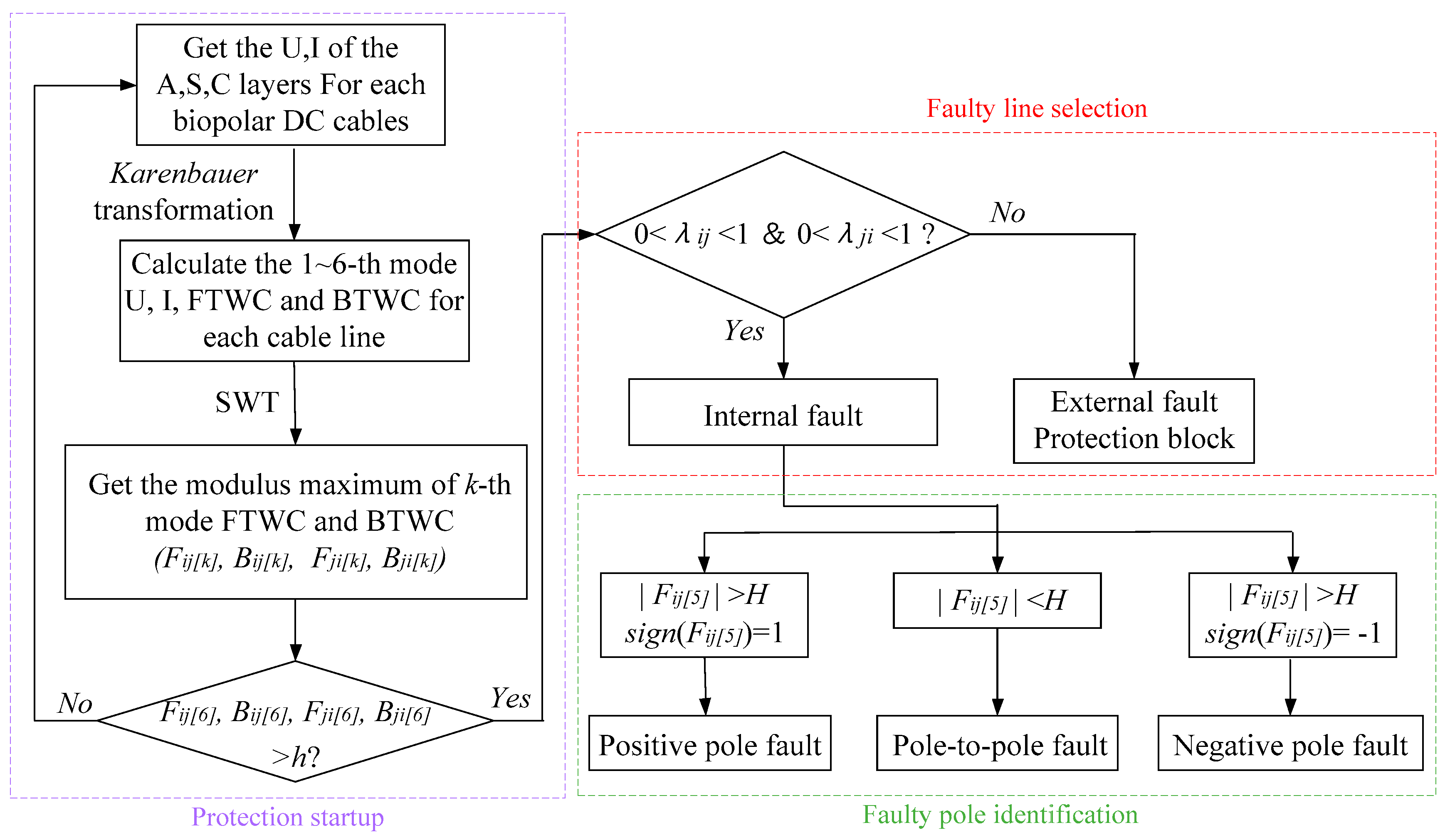
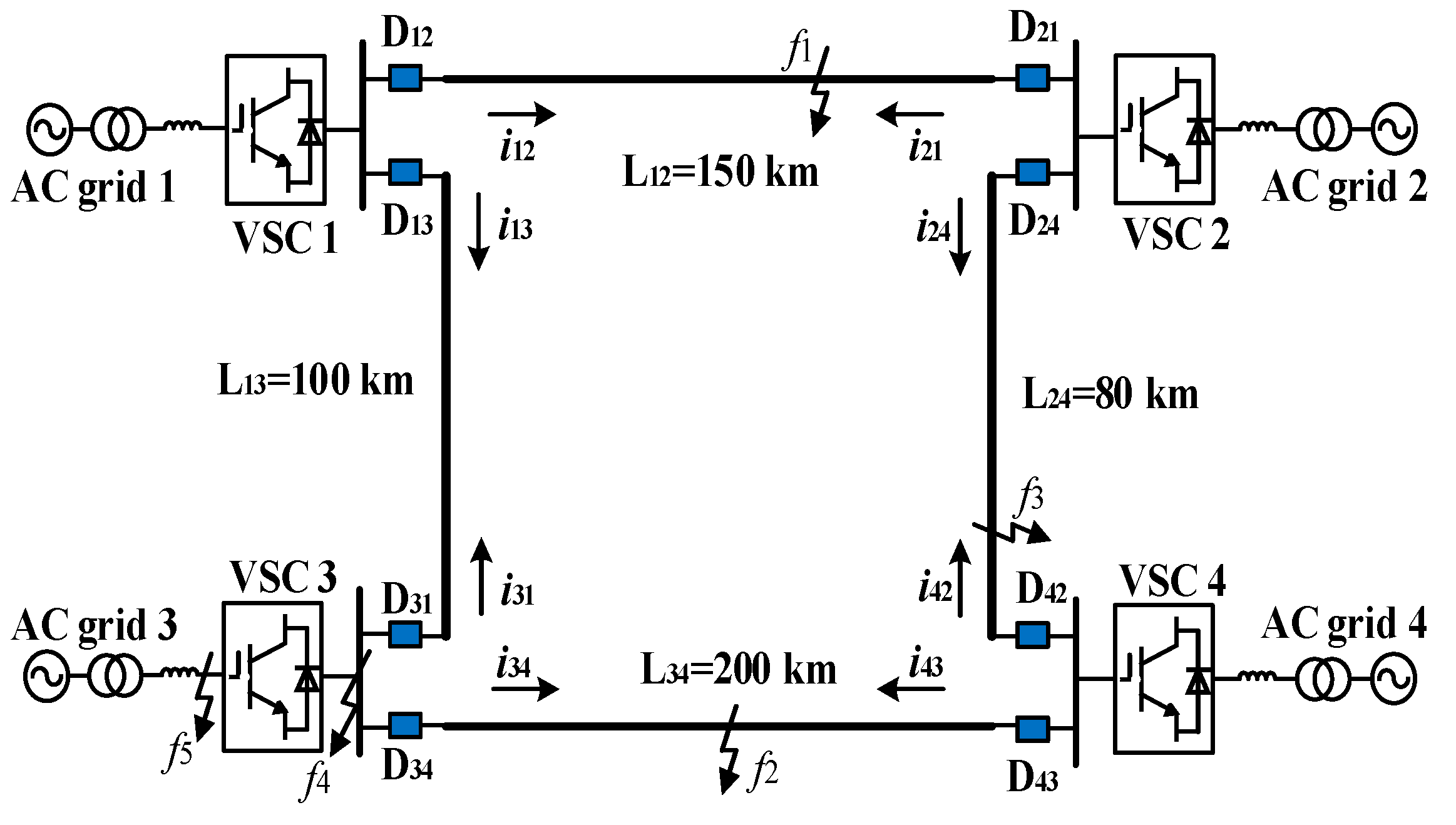

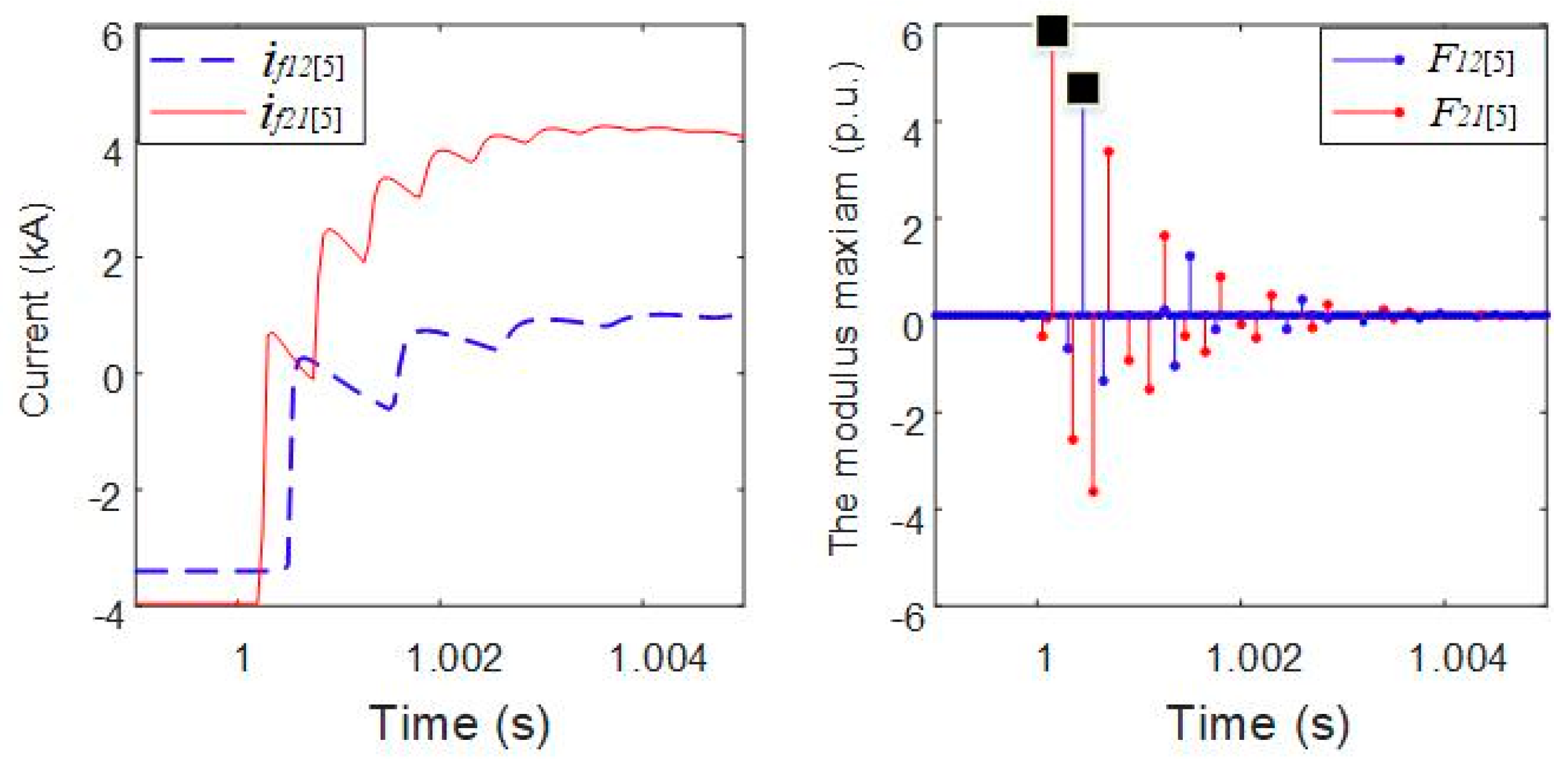
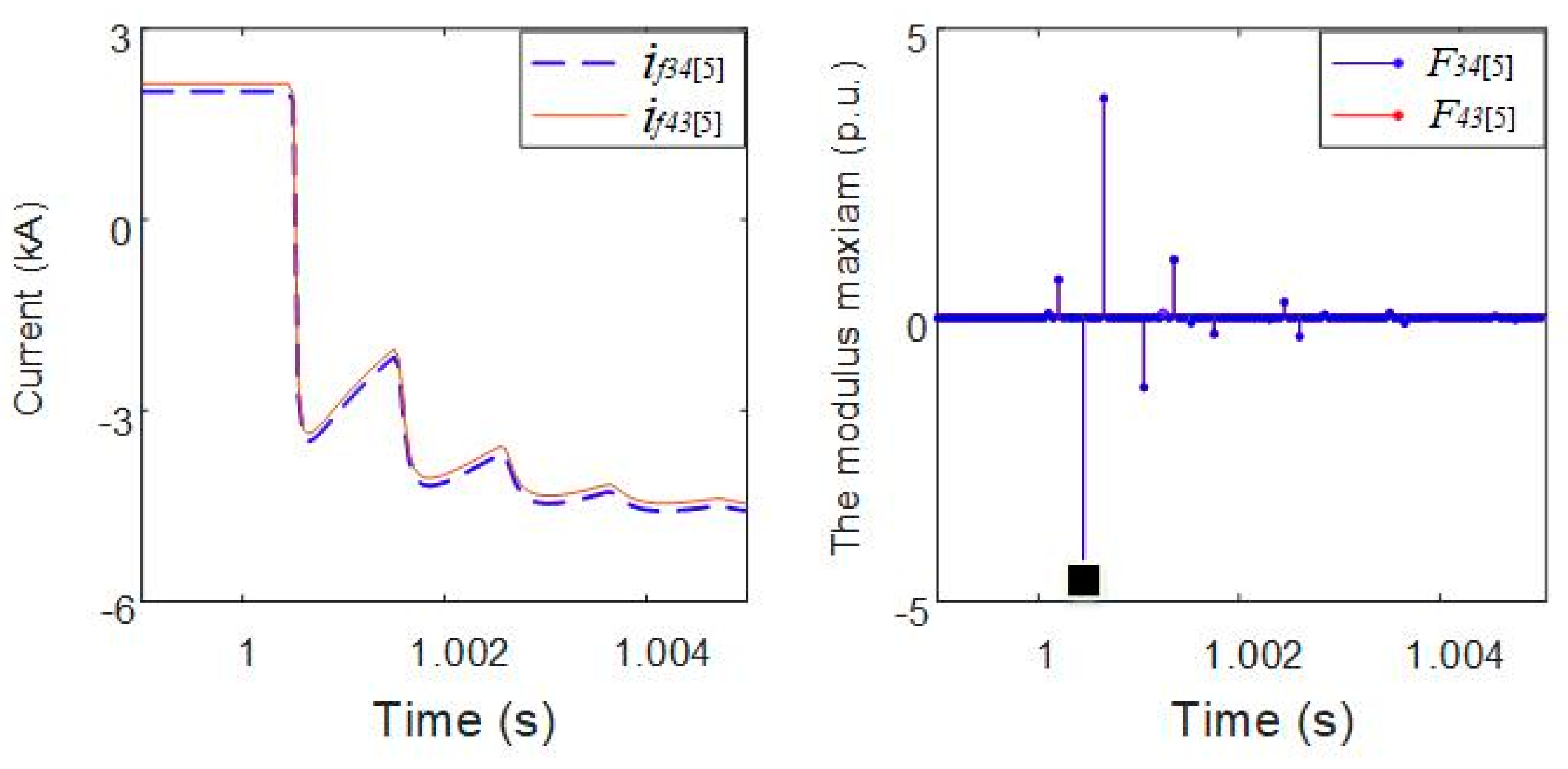
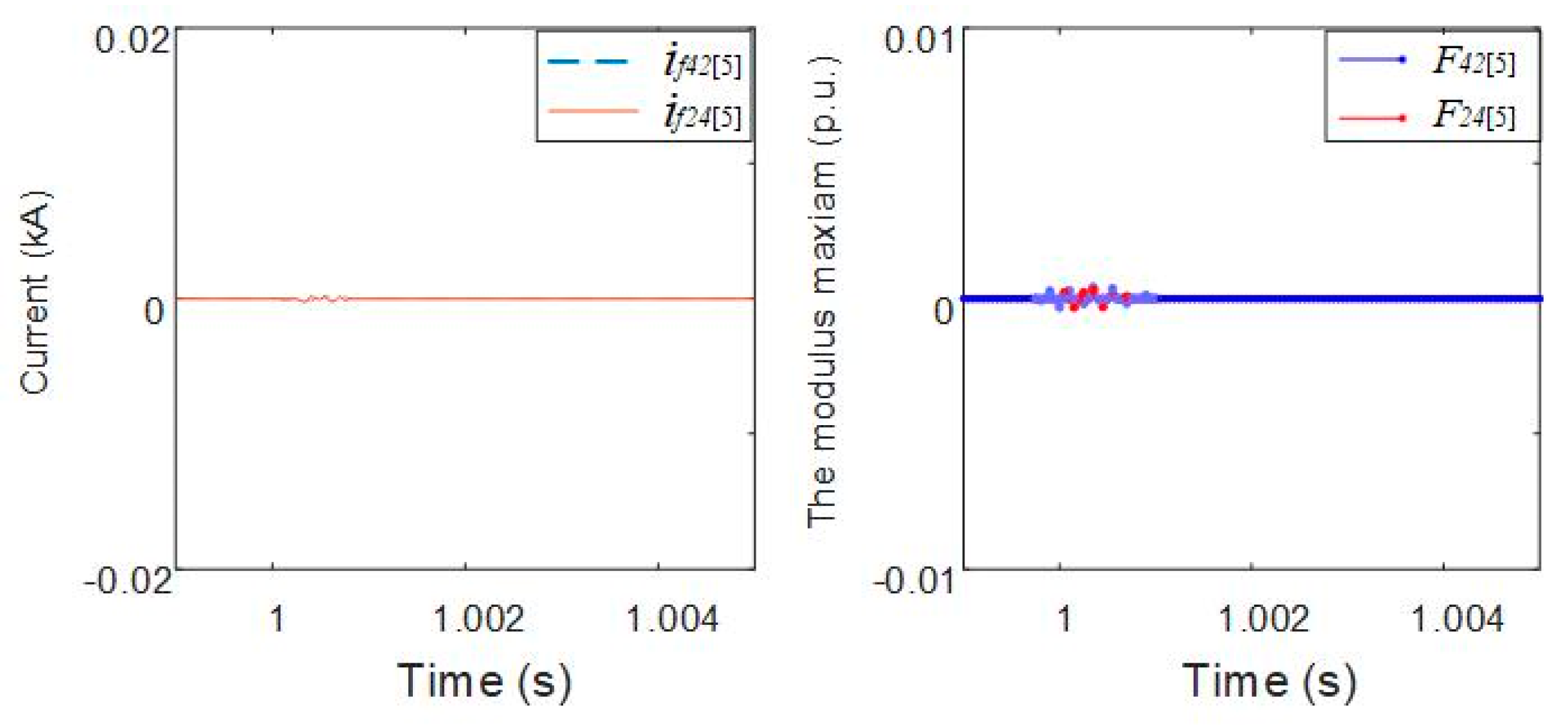
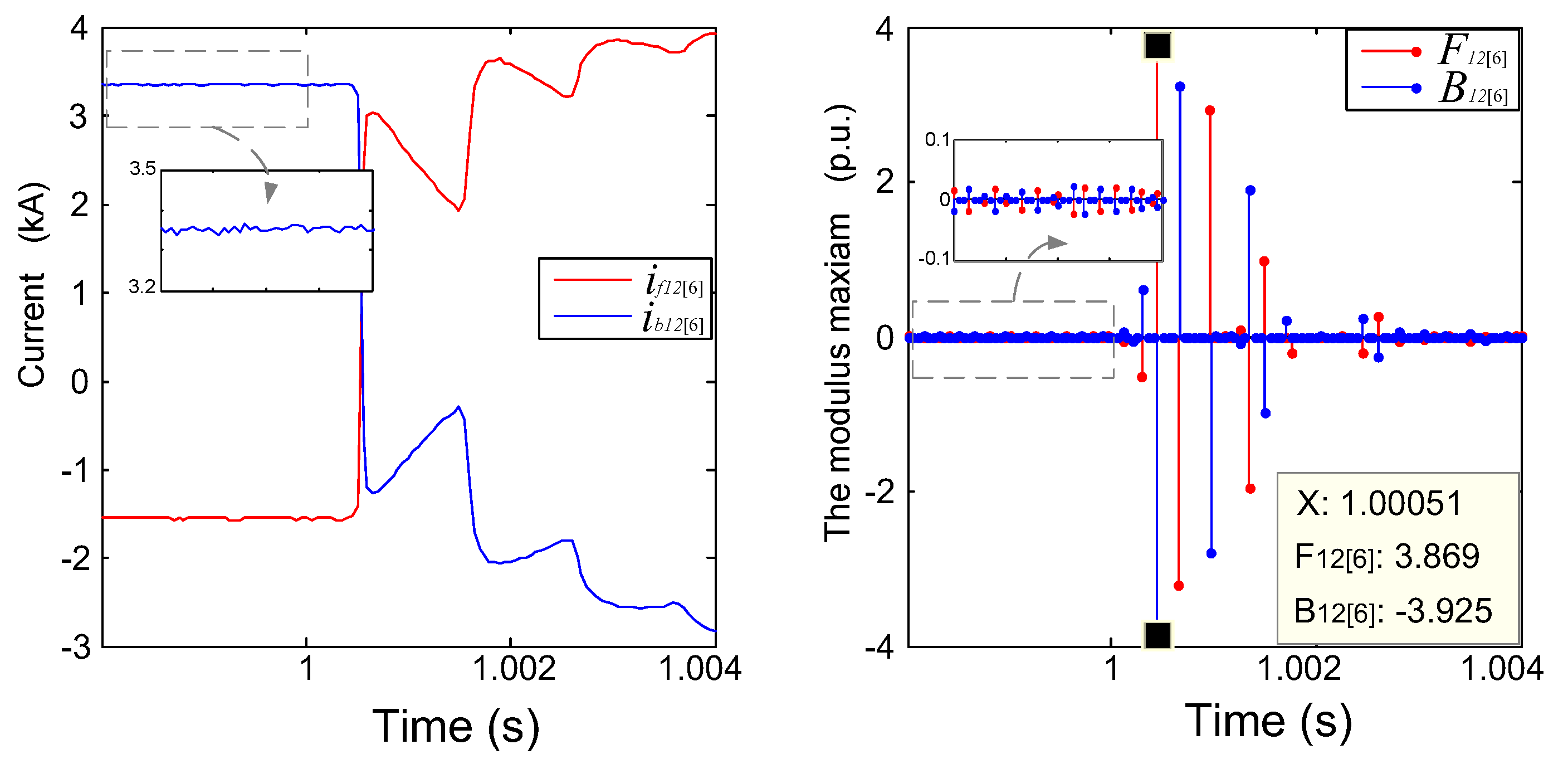
| Line ij | Fij[6] | Bij[6] | Fji[6] | Bji[6] | λij | λji | Identification Result |
|---|---|---|---|---|---|---|---|
| L12 | 3.831 | −3.858 | 4.890 | −4.928 | 0.986 | 0.985 | Fault segment |
| L13 | −0.868 | 0.304 | 0.538 | −0.544 | 8.153 | 0.978 | Normal |
| L24 | −1.100 | 0.431 | 0.831 | −0.855 | 6.514 | 0.945 | Normal |
| L34 | −0.498 | −0.308 | −0.697 | −0.178 | 2.614 | 15.333 | Normal |
| Line ij | Fij[6] | Bij[6] | Fji[6] | Bji[6] | λij | λji | Identification Result |
|---|---|---|---|---|---|---|---|
| L12 | −0.317 | −0.212 | −0.496 | −0.196 | 2.236 | 6.404 | Normal |
| L13 | 0.433 | −0.449 | −0.799 | 0.173 | 0.930 | 21.331 | Normal |
| L24 | 0.642 | −0.655 | −0.807 | 0.375 | 0.961 | 4.631 | Normal |
| L34 | 3.851 | −3.862 | 3.849 | −3.855 | 0.994 | 0.997 | Fault segment |
| Line ij | Fij[6] | Bij[6] | Fji[6] | Bji[6] | λij | λji | Identification Result |
|---|---|---|---|---|---|---|---|
| L12 | 0.422 | −0.438 | −0.943 | 0.188 | 0.928 | 25.160 | Normal |
| L13 | −0.387 | −0.341 | −0.688 | −0.167 | 1.288 | 16.972 | Normal |
| L24 | 5.541 | −5.583 | 6.722 | −6.794 | 0.985 | 0.979 | Fault segment |
| L34 | 0.814 | −0.839 | −1.197 | 0.332 | 0.941 | 12.999 | Normal |
| Line ij | Fij[6] | Bij[6] | Fji[6] | Bji[6] | λij | λji | Identification Result |
|---|---|---|---|---|---|---|---|
| L12 | −0.788 | 0.213 | 0.482 | −0.497 | 13.687 | 0.941 | Normal |
| L13 | 3.108 | −3.141 | −4.915 | 2.176 | 0.979 | 5.102 | Normal |
| L24 | −0.179 | −0.227 | −0.599 | −0.106 | 0.622 | 31.933 | Normal |
| L34 | −4.903 | 1.336 | 2.436 | −2.497 | 13.468 | 0.952 | Normal |
| Fault Resistance | Line ij | Fij[6] | Bij[6] | Fji[6] | Bji[6] | λij | λji | Fij[5] | Identification Result |
|---|---|---|---|---|---|---|---|---|---|
| 10 Ω | L12 | −0.259 | −0.174 | −0.445 | −0.143 | 2.216 | 9.684 | Normal | |
| L13 | 0.390 | −0.402 | −0.753 | 0.128 | 0.941 | 34.607 | Normal | ||
| L24 | 0.599 | −0.607 | −0.747 | 0.322 | 0.974 | 5.382 | Normal | ||
| L34 | 3.806 | −3.813 | 3.804 | −3.811 | 0.996 | 0.996 | 4.788 | Internal NG fault | |
| 200 Ω | L12 | −0.142 | Normal | ||||||
| L13 | 0.125 | −0.129 | −0.241 | 0.941 | Normal | ||||
| L24 | 0.192 | −0.194 | −0.239 | 0.103 | 0.974 | 5.382 | Normal | ||
| L34 | 1.522 | −1.525 | 1.522 | −1.524 | 0.996 | 0.996 | 1.924 | Internal NG fault | |
| 400 Ω | L12 | Normal | |||||||
| L13 | Normal | ||||||||
| L24 | Normal | ||||||||
| L34 | 0.251 | −0.252 | 0.251 | −0.252 | 0.996 | 0.996 | 0.282 | Internal NG fault |
© 2018 by the authors. Licensee MDPI, Basel, Switzerland. This article is an open access article distributed under the terms and conditions of the Creative Commons Attribution (CC BY) license (http://creativecommons.org/licenses/by/4.0/).
Share and Cite
Jiang, L.; Chen, Q.; Huang, W.; Wang, L.; Zeng, Y.; Zhao, P. Pilot Protection Based on Amplitude of Directional Travelling Wave for Voltage Source Converter-High Voltage Direct Current (VSC-HVDC) Transmission Lines. Energies 2018, 11, 2021. https://doi.org/10.3390/en11082021
Jiang L, Chen Q, Huang W, Wang L, Zeng Y, Zhao P. Pilot Protection Based on Amplitude of Directional Travelling Wave for Voltage Source Converter-High Voltage Direct Current (VSC-HVDC) Transmission Lines. Energies. 2018; 11(8):2021. https://doi.org/10.3390/en11082021
Chicago/Turabian StyleJiang, Lingtong, Qing Chen, Wudi Huang, Lei Wang, Yu Zeng, and Pu Zhao. 2018. "Pilot Protection Based on Amplitude of Directional Travelling Wave for Voltage Source Converter-High Voltage Direct Current (VSC-HVDC) Transmission Lines" Energies 11, no. 8: 2021. https://doi.org/10.3390/en11082021
APA StyleJiang, L., Chen, Q., Huang, W., Wang, L., Zeng, Y., & Zhao, P. (2018). Pilot Protection Based on Amplitude of Directional Travelling Wave for Voltage Source Converter-High Voltage Direct Current (VSC-HVDC) Transmission Lines. Energies, 11(8), 2021. https://doi.org/10.3390/en11082021





